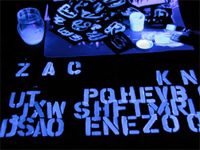INSIDE_OUT
June 27th, 2003
Categories: Applications, MFA Thesis, Multimedia, Networking, Software, VR Art

Authors
Gotsis, M.About
I grew up as an aspiring ballet dancer who was turned off by the required physical discipline and quickly distracted by the visual arts and technology. I continued practicing dance in other forms such as traditional folk, modern and Latin. My most significant influence in dance is my childhood friend, Irina Poulos currently a student choreographer at NYC Tisch School of the Arts, originally trained in ballet. My master’s thesis project “INSIDE_OUT” is the culmination of more than thirteen years of being a dance “voyeur” and an amateur performer. During the last two years, I have studied the possibilities of combining technology and dance and its historic evolution and I have experimented with my resources to a great extent. This paper outlines my research findings, how they fueled my efforts in the production of my MFA thesis show and my resulting observations from this experience.
THE EVOLUTION OF THE RELATIONSHIP OF DANCE AND TECHNOLOGY
Since the first attempts to computerize dance notation (such as Labanotation) in the 1970’s, it was conceived that dance and technology could compliment each other. Just because dance seems to be a self-sufficient art, it doesn’t mean that one couldn’t “accessorize”, expand and experiment, as Judith Gray would put it. Initial attempts to design computer-based dancers happened at Simon Frasier University with an ellipsoid body figure and at the Royal College of Art with a sphere-based model that could cast shadows. The pivotal moment for embracing a project like the above may have been the New York Institute’s 1983 “elegant dancer” created for Twyla Tharp’s video choreography “Catherine Wheel”.The development of computerized notation systems for dance has since opened the door for endless choreography experiments. Alice Trexler and Ronald Thornton notably used the first motion detection systems at Tufts University for cross-disciplinary purposes. One of the first notation systems to become computerized is Labanotation, which was conceived by Rudolf Laban in 1928. The system involves a shorthand system that requires training for interpretation but also allows for some room for improvisation by the dancer. This system has been developed so much that any type of movement can be mapped using it. Giving the dancer freedom to interpret a given choreography is a method that allows for more interesting experimentation and it expands the possible use of a notation system.
Resources
URL
Citation
Gotsis, M., INSIDE_OUT, Submitted as partial fulfillment of the requirements for the degree of Master of Fine Art, Graduate College, University of Illinois at Chicago, June 27th, 2003. http://www.evl.uic.edu/gotsis/thesis.pdf